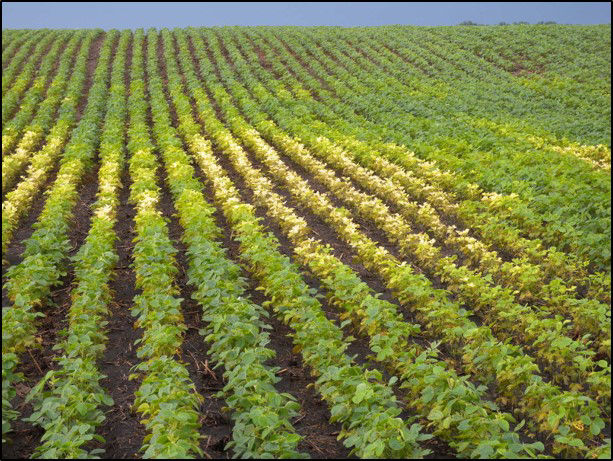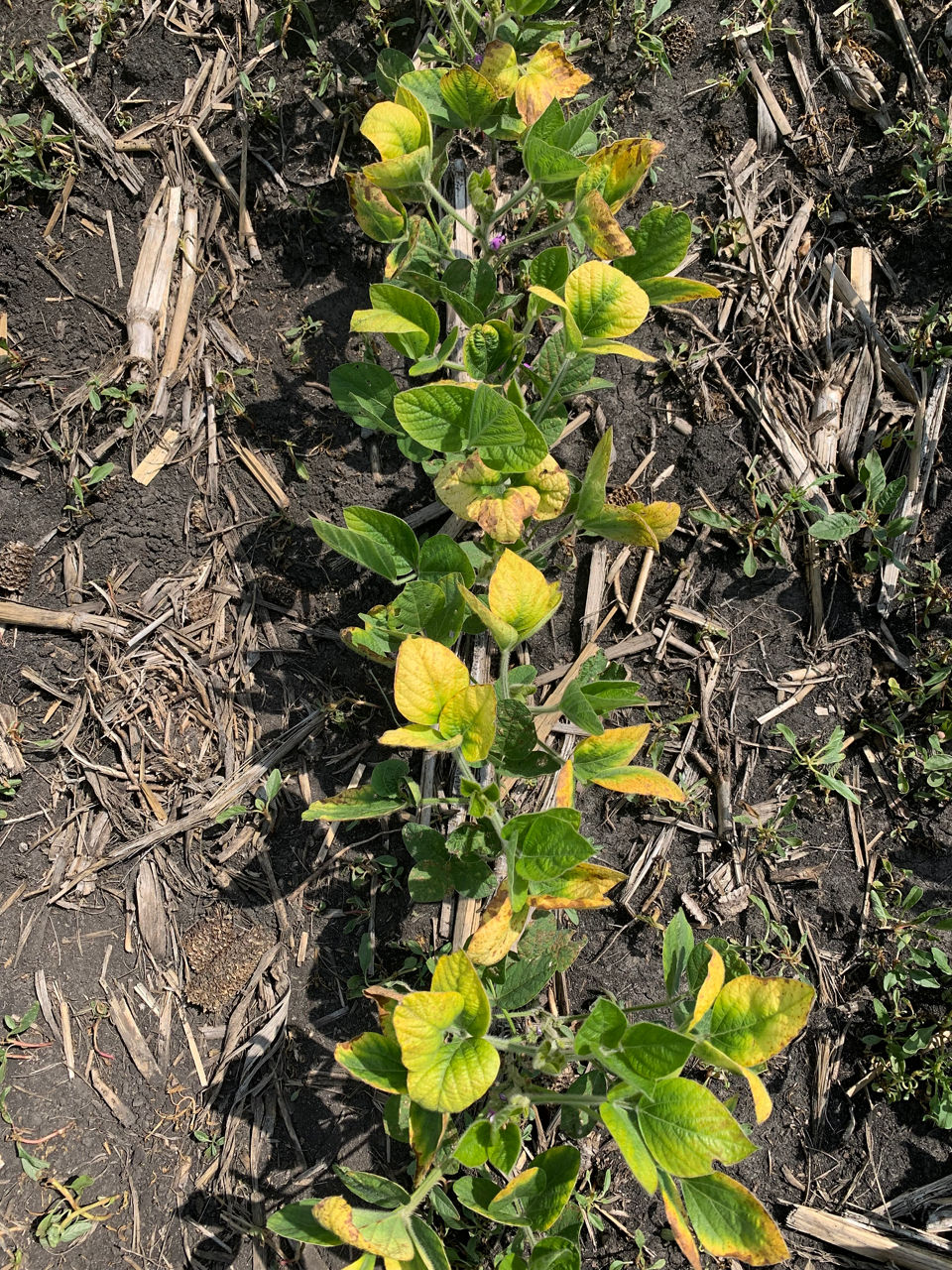Why are young vegetative soybean plants yellow?
February 15, 2025
Springtime will soon be here and with that comes another growing season. When crops are planted, we expect everything to emerge nicely and evenly; however, that isn’t always the case. Sometimes, patches of soybean plants can be seen that have turned yellow (chlorotic) when they should be green. Chlorotic plant tissue is the plant’s way to signal that something is not optimal at this given time. This is especially the case with soybean plants in the early vegetative stages. There are many reasons for soybean leaves to turn chlorotic and it’s important to determine several factors including the shade of yellow, where is the chlorosis and why it is occurring, and if there is a management option available. The three most common causes of young soybean plantings being chlorotic prior to the R1 growth stage are herbicide injury, fertility deficiencies, and root growth restrictions.
Young soybean seedlings can be sensitive to different herbicide chemistries as they encounter and metabolize them. Herbicide injury can be from either a direct application or an indirect (carryover or drift) application. It is important to take weather conditions, application timing, herbicide product, soil type and conditions, topographic locations, and application type into consideration when determining if herbicide injury is the potential cause of young soybeans turning chlorotic. Two of the most common herbicide groups (HG) that can cause yellowing in vegetative soybean plants are HG27 (HPPD Inhibitors) and HG5 (Photosystem II Inhibitors).
Herbicide injury from an HPPD Inhibitor is generally seen in young soybean plants (V1 to V4 growth stage) (Figure 1). HPPD inhibitor herbicide is a common corn herbicide and can cause crop injury to young soybean plants either through drift from a neighboring field or carry over from the previous corn crop. We generally see more carryover occurrences when there is a later HPPD inhibitor application the previous year and a very dry fall and winter prior to the soybean crop. HPPD inhibitor herbicides are a “bleacher” herbicide and can cause chlorosis to varying degrees from just along the leaf edge or throughout the entire leaf. Crop injury is typically seen on the newest leaf tissue. Generally, with rain and warm growing conditions the young soybean plants can continue to grow and grow out of these yellowing symptoms.

The other common herbicide group that can cause leaf chlorosis in young soybean plants is HG5, Photosystem II Inhibitors (Figure 2). The herbicide injury can be the result of direct application (via metribuzin) or indirect application (drift or carryover from atrazine). When crop injury occurs with this herbicide group, young soybean leaves usually have interveinal chlorosis and some necrosis in severe cases. This is commonly found in soybean plants that are VE to V2 growth stages where soils have a high pH or have some type of root growth restriction. Usually, young soybean plants can continue to grow out of these symptoms with warm conditions and good rainfall.

Fertility deficiencies are another common cause of chlorosis in crop plants. Iron Deficiency Chlorosis (IDC) and potassium (K) deficiency are two common nutrient deficiencies that can affect a young soybean plant and cause the leaves to turn chlorotic. Potassium deficiency and IDC can look similar from the field edge. Therefore, it is important to physically walk out to the affected areas to determine which nutrient deficiency is occurring.
Iron deficiency symptoms are chlorosis of the leaf area while the vein margins stay a dark green in soils that have a pH of 7.3 or greater. The chlorosis occurs on the upper portion of the plant where the new growth is and usually shows up between the V2 and V5 growth stages. Soybean IDC commonly occurs in low lying areas of a field where poor drainage and root growth restrictions can occur. Usually, IDC affected soybean plants are stunted and may have lower nodulation compared to those that are not affected. The best management option is to plant a soybean product that has good tolerance to IDC.

Potassium deficiency is commonly seen in soybean plants around the V2 to V6 growth stages. Potassium is a mobile nutrient in the plant and symptoms are generally seen on the older leaves at the bottom of the plant and are a bright chlorosis around the leaf margins. Potassium deficiency generally occurs due to reduced plant available K in the soil from restricted root growth. Generally, if the soil test is not low in K, deficiency symptoms may occur after a dry period as the roots have not been able to grow and reach more available K in the soil. Symptoms can diminish after the next rainfall as the plant root continue to grow. If the soil test is low for K, then an increase rescue application of a broadcast potassium fertilizer may be warranted to help protect yield potential.

General root restrictions are another common cause of why young soybean leaves turn chlorotic. When root growth is restricted, the young plant has a decreased amount of water and nutrients available for rapid growth and a short-term nutrient deficiency can occur. This can generally be caused by compaction, poor drainage, low lying areas, or around field edges. It is best to try and correct the compaction and drainage issues to improve crop health and performance. Generally, with good growing conditions, most soybean plants can continue to grow, and symptoms can be alleviated.
There are many reasons why soybean leaves are chlorotic prior to the reproductive stages. It is important to scout these locations and consider all options to determine why the leaves are yellow.
Please see Early Season Soybean Herbicide Injury and Common Causes for Yellowish Soybean Leaves for additional information.
If you have questions, please contact your local Channel® brand SeedPro.
Channel Agronomist
Katherine Rod
Sources
Anderson, M. and Hartzler, B. 2020. Identifying common herbicide symptoms in soybean. Integrated Crop Management Blog. Iowa State University Extension and Outreach. https://crops.extension.iastate.edu/blog/bob-hartzler-meaghan-anderson/identifying-common-herbicide-symptoms-soybean
Anderson, M. and Mallarino, A. 2021. What’s with all the yellow soybean? Integrated Crop Management Blog. Iowa State University Extension and Outreach. https://crops.extension.iastate.edu/blog/antonio-mallarino-meaghan-anderson/whats-all-yellow-soybean
Web sites verified 1/5/25 1110_502820